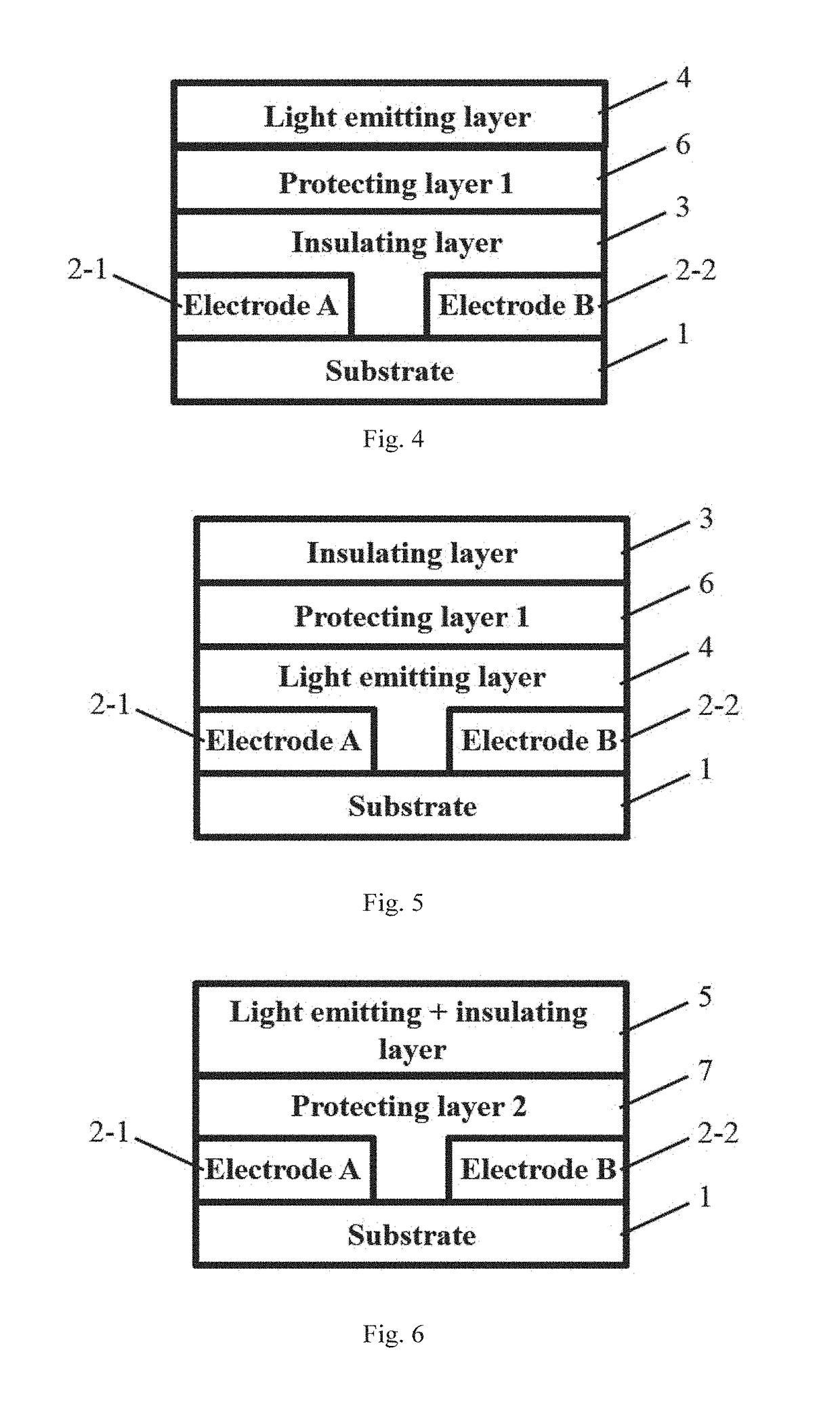Planar electroluminescent devices and uses thereof
a technology of electroluminescent devices and planar beams, applied in the field of electroluminescence, can solve the problems of difficult realization of potential applications, doubt of significance, and low attention on the subject of phenomenon, and achieve the effect of less luminance and reduced luminan
- Summary
- Abstract
- Description
- Claims
- Application Information
AI Technical Summary
Benefits of technology
Problems solved by technology
Method used
Image
Examples
example 1
[0138]In this example, PET plastic is used as a substrate, and the method of fabrication is screen printing. The structure of the planar electroluminescent device is shown in FIG. 1, comprising a substrate layer 1, an electrode layer, an insulating layer 3 and a light emitting layer 4. In one embodiment, the electrode layer includes electrode A 2-1 and electrode B 2-2. The electrodes are printed on the surface of the substrate 1 with gap in between, and form an electrode layer. Adjacent electrodes A 2-1 and the electrode B 2-2 are not in contact with each other. The electrode layer is sandwiched between the insulating layer 3 and the substrate layer 1. The light emitting layer 4 is fabricated on the surface of the insulating layer 3.
[0139]In one embodiment, in order to prevent the PET plastic substrate from shrinking in subsequent drying process, and prevent the electrodes from being bonded together to cause a short circuit, the PET plastic was dried in an oven at 100° C. for 30 min...
example 2
[0151]This example shows the relationships between different frequency, voltage and luminance when the planar electroluminescent device was configured as an electroluminescent writing board. Water is used as writing fluid.
Varying Input Voltage at Constant Frequency
[0152]Deionized water was dropped onto the planar electroluminescent device, and tested on a 3 cm×3 cm glass sheet area. EL cold light equipment was used to measure the luminance. The device was tested at constant frequency of 500 Hz, 1000 Hz, 1500 Hz, or 3000 Hz, whereas the input voltage was changed from 0 to 180 V. For example, at 500 Hz, the luminance was measured at 0-180 V; at 1000 Hz, the luminance was measured at 0-180 V; at 1500 Hz, the luminance was measured at 0-180 V; at 3000 Hz, the luminance was measured at 0-180 V.
[0153]As shown in FIG. 17, it can be seen that as the voltage is increased, the luminance is also increased. Also, as the frequency is increased, so is the luminance. And the luminance will eventua...
example 3
[0156]This example shows the effects of the size of the gap area between adjacent electrodes on luminance. Adjacent electrodes in the EL device of example 1 have a gap area between them at 0.5 mm wide. In this example, the space between electrodes A and electrodes B is varied to 0.4 mm, 1.0 mm, 1.75 mm, or 3.2 mm. Other parts of the EL device are arranged as in those in Example 1.
[0157]Deionized water was dropped onto the planar electroluminescent device, and tested on a 3 cm×3 cm glass sheet area. EL cold light equipment was used to measure the luminance. Luminance was measured at 1000 Hz at 60 V, 100 V, 120 V, or 140 V. As shown in FIG. 19, the luminance decreases when the gap width of the electrodes increases. And at higher voltage, the change in the amplitude of the luminance is also greater.
PUM
| Property | Measurement | Unit |
|---|---|---|
| conductivity | aaaaa | aaaaa |
| internal quantum efficiency | aaaaa | aaaaa |
| size | aaaaa | aaaaa |
Abstract
Description
Claims
Application Information
 Login to View More
Login to View More - R&D
- Intellectual Property
- Life Sciences
- Materials
- Tech Scout
- Unparalleled Data Quality
- Higher Quality Content
- 60% Fewer Hallucinations
Browse by: Latest US Patents, China's latest patents, Technical Efficacy Thesaurus, Application Domain, Technology Topic, Popular Technical Reports.
© 2025 PatSnap. All rights reserved.Legal|Privacy policy|Modern Slavery Act Transparency Statement|Sitemap|About US| Contact US: help@patsnap.com



